II. Fauna: Mammals, Reptiles...
Wild yak, which is adapted to very low temperatures is quite common in this area. It is the ancestor of the domestic yak (Figure 54), which plays a pivotal role in the life of native people of Changthang in eastern Ladakh. Chiru or the Tibetan antelope is another animal that is adapted to the harsh Tibetan plateau, which extends into eastern Ladakh. It has large nasal cavities to cope up with the thin air, and soft underwool to fight against the fierce elements of the plateau. This wool also known as Shahtoosh or locally Rtsoskhul, is one of the finest animal fibers in the world. The Tibetan argali the largest wild sheep in the world, and the Tibetan gazelle are the other species here. Apart from these, there are animals that use more rugged terrains. For example, the Asiatic ibex and blue sheep are animals adapted to rugged terrain, the former more so than the latter. These ungulate species overlap in their habitat use in some areas, but they have exclusive geographical ranges in Ladakh with the ibex occurring mostly in the western part and blue sheep occurring in the eastern half, which is telltale of competitive interactions between the two. Ladakh urial endemic to the region is distributed only along two major rivers: Indus and the Shayok.
The Tibetan wild ass or Kiang (Figure 55) is the largest wild ass in the world with some stallions standing 1.4 m tall and weighing upto 400 kg. The colour is auburn with white belly, chest and legs, and morphologically the sexes are alike.
Apart from large herbivores, there are several small and less celebrated plant eating mammals. The most prominent among them is the marmot (Figure 58), of which there are two species in Ladakh: Himalayan marmot and long-tailed marmot. Two species of hare are Tibetan woolly hare (Figure 57) and Cape hare. Others include six species of pika and two species of vole (small burrowing mammals). Mammals with their IUCN Conservation status are listed in Table 6 given next.
Table 6: Mammals of Pangong Tso Wetland
| Common name |
Scientific Name |
IUCN - Status |
| Snow Lepord |
Unica unica |
Endangered |
| Ladakh Urial |
Ovis vignei |
Vulnerable |
| Tibetan Gazelle |
Procapra picticaudata |
Near Threatened |
| Royle's Mountain Vole |
Alticola roylei |
Near Threatened |
| Pallas's Cat |
Otocolobus manul# |
Near Threatened |
| Great Tibetan Sheep |
Ovis ammon |
Near Threatened |
| Tibetan Wolf |
Canis lupus chanku |
Least Concern |
| Tibetan Wild Ass |
Equus kiang kiang* |
Least Concern |
| Red Fox |
Vulpes vulpes |
Least Concern |
| Large-eared Pika |
Ochotona macrotis |
Least Concern |
| Himalayan Marmot |
Marmota himalayana |
Least Concern |
| Blue Sheep |
Pseudois nayaur |
Least Concern |
| Wild Dog |
|
|
* Sightings - Study site. # Recorded at Hanlay.
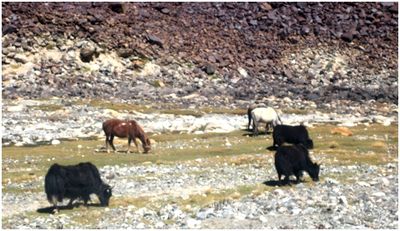
Figure 54. Yak
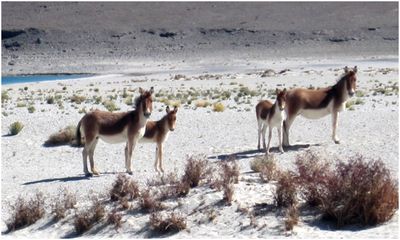
Figure 55: Equus kiang
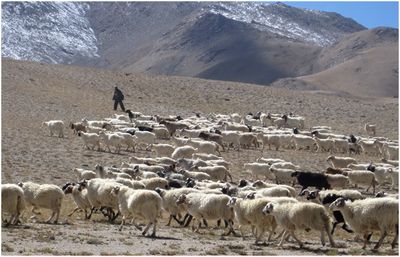
Figure 56. Pashmina goat
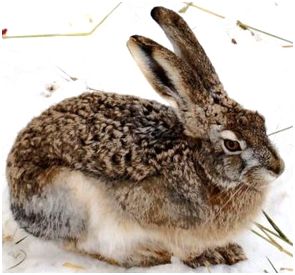
Figure 57: Wooly himalyan Hare
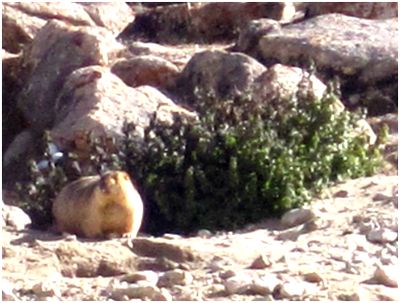
Figure 58: Marmoot
Snow Leopard (Ladhaki: Shan): The Snow Leopard (Unica unica) is one of the most elusive and endangered big cats, found in the mountainous region of Central Asia and has been recorded from parts of Russia, Mongolia, China, Nepal, Tibet, Bhutan, Pakistan, India, Afghanistan and north-east range over the Pamir, Tienshan and Altai mountains. In India, it is found throughout the alpine zone of the main Himalayan range. It is reported from Jammu & Kashmir, Himachal Pradesh, Uttarakhand, Sikkim and Arunachal Pradesh. It is encountered throughout Ladakh, mostly in the south and central regions between 3000 and 5000m. In Ladakh it can be best sighted within Hemis National Park and Zanskar valley. Its estimated population throughout Ladakh region is around 250-350 animals. Throughout its entire range the estimated population of Snow Leopard is 7000 individuals. Due to the recent conservation efforts, their numbers are probably increasing, but sharp declines in populations have been reported over the past decade from parts of the species range. Globally, high levels of hunting for the animal’s skin and for live animals, for zoos, during the last century contributed to the species endangered status, but in India the primary threat relates to decimating wild prey as a result of over grazing in parts of the range ,and locally increasing damage to livestock that may lead to retaliatory killing of the animals and lessening toleration towards conservation. Since the 1970’s legal measures were taken for its protection in India. It is listed as Endangered in the IUCN Red List of Threatened Animals, under Appendix 1 in CITES and Under Schedule 1 in the Jammu & Kashmir Wildlife (Protection) Act, 1978 (Shawl et al., 2008).
Ladakh Urial (Ladakhi: Shapo): Ladakh Urial (Ovis vignei) is endemic to Ladakh and has a very restricted distribution. Its distribution is along the major valleys of the rivers Indus and Shyok. As these valleys are heavily populated this brings this species into direct conflict with humans. The total estimated population of this species in Ladakh is about 1500 individuals. Its number is declining drastically due to disturbance and habitat loss. As per reports it has been exterminated from several areas and survives only in small isolated populations. The Urial is best sighted in areas surrounding Fotu La, Nindum and between Lamayuru, Rhizong and Wanla. In Kargil district the animal is reported from Junkar range and between Chiktan and Jukshu. The population is showing a declining trend. The animal is listed as Vulnerable in the IUCN Red List of Threatened Animals and comes under Appendix 1 in the CITES and Schedule 1 of the Jammu & Kashmir Wildlife (Protection) Act, 1978 (Shawl et al., 2008).
Tibetan Gazelle: Tibetan Gazelle (Procapra picticaudata) is distributed in Tibet and Sikkim. Once fairly common in Changthang region of Ladakh, it has since been wiped out completely from most of its range.The estimated population in Ladakh region is between 70-80 animals.The animals were best recorded from Kalak-Tartar plains south of Hanle valley. It is recorded as Near Threatened under the IUCN Red List of threatened Animals, under Schedule 1 of the Jammu & Kashmir Wildlife (Protection) Act, 1978 and under Appendix 1 of CITES (Shawl et al., 2008).
Royle’s Mountain Vole: Royle's Mountain Vole (Alticola roylei) is endemic to northern India, where it is distributed in the western Himalayas from Kulu Valley in Himachal Pradesh to Kumaon in Uttarakhand (Molur and Nameer, 2008). In Ladakh it is a common resident of western and southern portion at around 3000 to 3300m and above. This animal is best seen in and around Panikar upto Suru Valley, the Zanskar and Changchu valley (Shawl et al., 2008). This species is listed as Near Threatened under the IUCN Red List of threatened Animals, because this species is probably in significant decline because of widespread habitat loss through much of its range, thus making the species close to qualifying for Vulnerable under criterion A2c (Molur and Nameer, 2008).
Pallas’s Cat: In India, Pallas’s Cat (Otocolobus manul) is found only in eastern Ladakh at an elevation between 3000 to 4800m. It is represented by three races and is distributed throughout Tibet, France, and Pakistan. The Pallas’s Cat in Ladakh is best seen in Rupshu/ Changthang area. The subspecies found in Ladakh is Otocolobus manulnigripectus. This cat was hunted extensively for its fur. This cat has been placed under Schedule I of the Indian Wildlife (Protection Act, 1972 and Appendex II of CITES (Shawl et al., 2008).
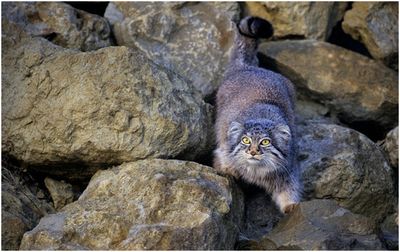
Figure 59: Pallas Cat
Great Tibetan Sheep / Argali: Great Tibetan Sheep (Ovis ammon) is found in northeastern Afghanistan, China (Gansu, Inner Mongolia, Qinghai, possibly western Sichuan, Tibet, and Xinjiang), northern India (Ladakh, Sikkim, and Spiti), eastern Kazakhstan, eastern Kyrgyzstan, Mongolia, northern Nepal (near the Chinese border), extreme northern Pakistan, Russia (Tuvan and Altai Republics in the Altai Mountains), eastern Uzbekistan, and eastern Tajikistan. There are no recent records of argali occurrence in Bhutan. Within India, argali are restricted to the eastern plateau of Ladakh, a nearby area in Spiti (Himachal Pradesh), and, separately, in northern Sikkim adjacent to Tibet. Indian biologists consider these animals O. a. hodgsoni.
The main threats are over-hunting and poaching (for meat); competition, displacement and possibly disease transmission by domestic livestock; and habitat loss. In general, argali appear to be extremely intolerant of human disturbance. Argali are listed as a threatened species by the Government of India and are fully protected under Jammu and Kashmir’s Wildlife Act of 1978. Poaching appears to have declined in recent years, but has evidently not been accompanied by an increase in argali. Little has been done to address the likely deleterious effects of displacement increasing numbers of livestock on argali in Ladakh. Argali are rare but present in Khangchengzonga National Park in Sikkim. This species is listed as Near Threatened under the IUCN Red List of threatened Animals, because this species is believed to be in significant decline (but probably at a rate of less than 30% over three generations, taken at 24 years) due to poaching and competition with livestock, making the species close to qualifying for Vulnerable under criterion A2de. (Harris and Reading, 2008).
Reptiles: Reptiles of Pangong Tso Wetland.
- Phynocephalus theobaldi
- Laudakia himalayana
- Cyrtodactylus monttium salsorum
- Cyrtodactylus lawdernus
- Scineella himalayanum
- Coluber rhodorachis
- Ptyas mucosus
In this study, reptiles were not sited from the study region. But Toad-headed Agama (Phrynocephalus theobaldi) Figure 60, were sited near Hanley. The Toad-headed Agama is a medium sized insectivorous agama of the desert. It found in Himalayas upto 5000 m. The lizard's ear is hidden and the eyelids are strongly projected which acts as a barrier to the entrance of sand when the eyes are closed (Daniel, 2002; Murthy, 1995).
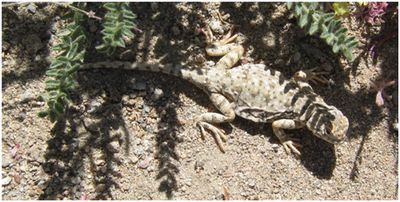
Figure 60. Phrynocephalus theobaldi
Mollusc: The Mollusc shells collected from Pangong Lake were identified using Ramakrishna and Dey (2007). Pangong Lake has four species of freshwater molluscs via. Radix brevicauda, Radix lagotis, Valvata piscinalis, and Gyraulus sp (Figure 61a to d). The distribution of Radix brevicauda, Radix lagotis, and Valvata piscinalis are reported only from Jammu and Kashmir in India. Even though, the molluscs shells collected from Pangong Lake are common in Ladakh region, these species were first time recorded from Pangong Lake. This indicates overlook or absence of biodiversity survey in the Pangong Lake, except Sharma (2000) who discovered a fossil molluscs Lymnea auricularia in ancient lacustrine clay deposits above the present level of the lake.

INSECTS: Insects are important pointers for species-rich geographical areas. Qualitatively, they are also important, whether, the subject of conservation themselves or as a tool for identifying areas with high endemism. Insects are a dominant and ancient group of animals on the earth. Over one and half million living and about 12,000 species of fossil insects have been identified and described all over the world and they represent about 90 per cent diversity documented for the animal kingdom (Uniyal, 2001).
Table 7: List of insect species of the Changthang Wildlife Sanctuary
| Insect Orders |
Family |
Species |
Location |
Habitat |
| 1.Coleotpera |
Carabidae |
Bembidion ladas
Bembidion sp.
Amara sp. |
Tso-Moriri
Tsokar
Nyoma
Diskit, Leh |
Marsh vegetation
Light trap
Ground vegetation |
| Lepidoptera(Butterflies) |
Pieridae |
Pieris glauconame
Pieris brassicae
Colias cocandica
Colias sp. |
Leh
Drass
Tsokar
Kargil |
Agriculture fieldGround vegetation |
| Moths |
Sphingidae |
1 sp. |
Nyoma |
Light trap |
| Diptera |
i. Ephydridae |
Ephydra glauca |
Tsokar |
Marsh vegetation |
| ii. Chironomidae |
Micropsectra glacies
Micropsectra himachali
Agromyza sp. |
Tso-Moriri |
Marsh vegetation |
| Orthoptera |
Acrididae |
2 sp. |
Tsokar |
Ground vegetation |
Zooplankton: Zooplanktons of Panggong Tso wetland are Keratella sp., Alona sp., Daphnia sp. Gammarus sp. Cyclops sp.
Wildlife Sanctuary: Pangong Tso- is one of the Wet-site of Changthang Cold desert Wild life sanctuary. The area remained notified as Wildlife Protected area under SRO no. 155 dt. 19-03-1987 issued under the purview- of the J&K Wildlife protection Act (1978) section 17. The ownership of the wet-site remains with the Department of Wildlife Protection J&K State Leh Division” However, there are some revenue lands in the surrounding areas of Spangmik, Man, Merak, Chushul. One such land (Figure 5) on the bank of Pangong Tso, at Man, Merak is owned by Indian Astronomical Observation to understand the fundamental processes taking place on the Sun.